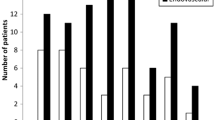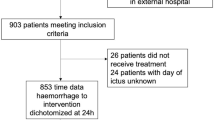Abstract
Background
Data of patients suffering from delayed second subarachnoid haemorrhage (SAH) after aneurysm treatment are still missing. Patients become clearly older than before. Thus, the risk suffering from a second delayed SAH rises. The aim of this study was to analyse clinical outcome and prognostic factors in patients after delayed second SAH.
Method
From 1999 to 2013, 18 of 1,493 patients (1.2%) suffered from a second SAH. Clinical and radiological characteristics were entered into a prospective conducted database. Outcome was assessed according to modified Rankin Scale 6 months after second SAH. P < 0.05 was considered statistically significant.
Results
Eighteen patients were admitted to our department with a second SAH. The second SAH occurred at a mean interval of 144 months after surgical treatment and 78 months after endovascular treatment (P < 0.05), with an overall mean interval of 125 months. The earliest event of second SAH was after 35 months. In 11 (61%) patients, a de novo aneurysm was detected; in one patient (6%), no cause of second SAH was detected. In six (33%) cases, re-rupture of the formerly secured aneurysm was found. Half of the rebleedings occurred from a basilar aneurysm, 33% from an aneurysm of anterior communicating artery and in one patient from a median cerebral artery aneurysm. At second SAH, 8 of 18 patients presented WFNS grade I-III at time of admission (44%). Overall, favourable outcome was achieved in seven patients (39%). Four patients died (22%), one of them before treatment. Favourable outcome seems to be associated with younger age. In our patients, 39% achieved a favourable outcome after second SAH.
Conclusions
A delayed second SAH is a rare entity. After delayed second SAH, age seems to be a prognostic factor for patients’ outcome and patients seem to have a worse prognosis. Nonetheless, up to 40% of patients can achieve a favourable outcome.



Similar content being viewed by others
References
Cha KC, Kim JH, Kang HI, Moon BG, Lee SJ, Kim JS (2010) Aneurysmal rebleeding: factors associated with clinical outcome in the rebleeding patients. J Korean Neurosurg Soc 47(2):119–123
Feuerberg I, Lindquist C, Lindqvist M, Steiner L (1987) Natural history of postoperative aneurysm rests. J Neurosurg 66(1):30–34
Gruber A, Dietrich W, Czech T, Richling B (1997) Recurrent aneurysmal subarachnoid haemorrhage: bleeding pattern and incidence of posthaemorrhagic ischaemic infarction. Br J Neurosurg 11(2):121–126
Haug T, Sorteberg A, Finset A, Lindegaard K-F, Lundar T, Sorteberg W (2010) Cognitive functioning and health-related quality of life 1 year after aneurysmal subarachnoid hemorrhage in preoperative comatose patients (Hunt and Hess Grade V patients). Neurosurgery 66(3):475–484, discussion 484–5
van Heuven AW, Dorhout Mees SM, Algra A, Rinkel GJE (2008) Validation of a prognostic subarachnoid hemorrhage grading scale derived directly from the Glasgow Coma Scale. Stroke 39(4):1347–1348
Juvela S, Porras M, Heiskanen O (1993) Natural history of unruptured intracranial aneurysms: a long-term follow-up study. J Neurosurg 79(2):174–182
Juvela S, Porras M, Poussa K (2000) Natural history of unruptured intracranial aneurysms: probability of and risk factors for aneurysm rupture. J Neurosurg 93(3):379–387
Konczalla J, Platz J, Brawanski N, Güresir E, Lescher S, Senft C, du Mesnil de Rochemont R, Berkefeld J, Seifert V (2015) Endovascular and surgical treatment of internal carotid bifurcation aneurysms: comparison of results, outcome, and mid-term follow-up. Neurosurgery 76(5):540–350, discussion 550–1
Larsen CC, Astrup J (2013) Rebleeding after aneurysmal subarachnoid hemorrhage: a literature review. World Neurosurg 79(2):307–312
Molyneux AJ, Birks J, Clarke A, Sneade M, Kerr RSC (2015) The durability of endovascular coiling versus neurosurgical clipping of ruptured cerebral aneurysms: 18 year follow-up of the UK cohort of the International Subarachnoid Aneurysm Trial (ISAT). Lancet 385(9969):691–697
Molyneux AJ, Kerr RSC, Birks J, Ramzi N, Yarnold J, Sneade M, Rischmiller J (2009) Risk of recurrent subarachnoid haemorrhage, death, or dependence and standardised mortality ratios after clipping or coiling of an intracranial aneurysm in the International Subarachnoid Aneurysm Trial (ISAT): long-term follow-up. Lancet Neurol 8(5):427–433
Molyneux A, Kerr R, Stratton I, Sandercock P, Clarke M, Shrimpton J, Holman R International Subarachnoid Aneurysm Trial (ISAT) of neurosurgical clipping versus endovascular coiling in 2143 patients with ruptured intracranial aneurysms: a randomized trial. J Stroke Cerebrovasc Dis 11(6):304–314
Ohkuma H, Tsurutani H, Suzuki S (2001) Incidence and significance of early aneurysmal rebleeding before neurosurgical or neurological management. Stroke 32(5):1176–1180
Raymond J, Guilbert F, Weill A, Georganos SA, Juravsky L, Lambert A, Lamoureux J, Chagnon M, Roy D (2003) Long-term angiographic recurrences after selective endovascular treatment of aneurysms with detachable coils. Stroke 34(6):1398–1403
Rinkel GJE, Algra A (2011) Long-term outcomes of patients with aneurysmal subarachnoid haemorrhage. Lancet Neurol 10(4):349–356
Roy D, Milot G, Raymond J (2001) Endovascular treatment of unruptured aneurysms. Stroke 32(9):1998–2004
Spetzler RF, McDougall CG, Zabramski JM, Albuquerque FC, Hills NK, Russin JJ, Partovi S, Nakaji P, Wallace RC (2015) The barrow ruptured aneurysm trial: 6-year results. J Neurosurg 123(3):609–617
Tsutsumi K, Ueki K, Morita A, Usui M, Kirino T (2001) Risk of aneurysm recurrence in patients with clipped cerebral aneurysms: results of long-term follow-up angiography. Stroke 32(5):1191–1194
Tsutsumi K, Ueki K, Usui M, Kwak S, Kirino T (1998) Risk of recurrent subarachnoid hemorrhage after complete obliteration of cerebral aneurysms. Stroke 29(12):2511–2513
Wermer MJH, Greebe P, Algra A, Rinkel GJE (2005) Incidence of recurrent subarachnoid hemorrhage after clipping for ruptured intracranial aneurysms. Stroke 36(11):2394–2399
Acknowledgements
We thank Anne Sicking and Marina Heibel for their excellent technical support.
Authors’ contributions
J.K., J.P., M.B. and N.B. collected and analysed the data. J.K. performed statistical analysis. N.B. drafted the manuscript. C.S., J.B., J.K. and V.S. contributed to critical revision of the manuscript for important intellectual content. J.K. and V.S. critically supervised the manuscript. All authors read and approved the final manuscript.
Author information
Authors and Affiliations
Corresponding author
Ethics declarations
Competing interests
The authors declare that they have no competing interests.
Funding
No funding was received for this research.
Conflict of interest
J.B.: Consulting fee or honorarium: proctor for WEB, Sequent Medical and a member of the scientific advisory board of Acandis. There is a permanent scientific cooperation between Siemens Healthcare AG and the Institute of Neuroradiology and travel expenses for presentation of projects are covered by the company. Except this, all authors certify that they have no affiliations with or involvement in any organisation or entity with any financial interest (such as honoraria; educational grants; participation in speakers’ bureaus; membership, employment, consultancies, stock ownership, or other equity interest; and expert testimony or patent-licensing arrangements), or non-financial interest (such as personal or professional relationships, affiliations, knowledge or beliefs) in the subject matter or materials discussed in this manuscript.
Informed consent
For this type of study formal consent is not required.
Appendix 1
Appendix 1
Rights and permissions
About this article
Cite this article
Brawanski, N., Platz, J., Bruder, M. et al. Outcome and prognostic factors after delayed second subarachnoid haemorrhage. Acta Neurochir 159, 307–315 (2017). https://doi.org/10.1007/s00701-016-3045-4
Received:
Accepted:
Published:
Issue Date:
DOI: https://doi.org/10.1007/s00701-016-3045-4




